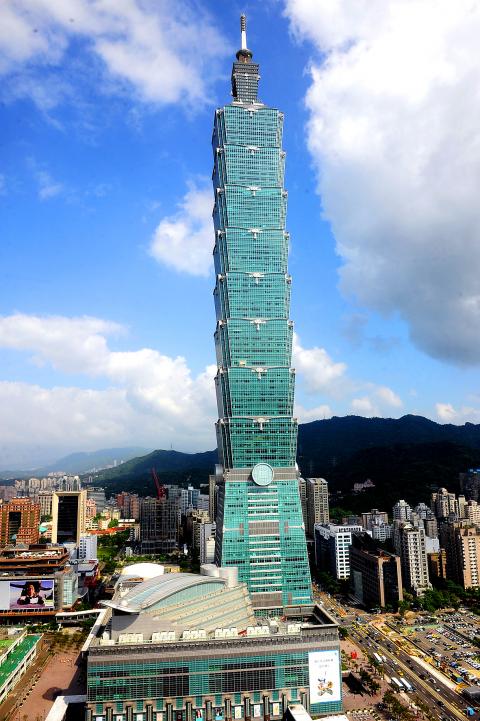Taipei 101 has been named as one of mankind’s greatest engineering achievements on a list recently compiled by US news network CNN.
Once the world’s tallest building in 2004, it is now the third tallest. Taipei 101 was the first building to be above 500m, CNN said.
It also had the world’s fastest elevator when it was completed, CNN added.

Photo: Chang Chia-ming, Taipei Times
The broadcaster said it decided to compile the list following a series of announcements in recent months about impressive building projects, such as Dubai’s plan to build the world’s biggest shopping mall.
Other skyscrapers on list of 25 construction or engineering feats include the Burj Khalifa in Dubai, the Shanghai World Financial Center in China and the CN Tower in Toronto, Canada.
The modern structures featured on the list are the Palm in Dubai, the Trans-Siberian Railroad in Russia, Japan’s Akashi Kaikyo Bridge in Kobe, Tokyo Sky Tree and Kansai Airport in Osaka, the US’ Hoover Dam, Golden Gate Bridge and Grand Canyon Skywalk, Canada’s White Pass and Yukon Route Railroad and Confederation Bridge, France’s Eiffel Tower and Millau Viaduct, London’s Underground system, the Panama Canal and the International Space Station.
The list also covered historical structures, including the Colosseum in Rome; the Great Pyramid of Giza, Egypt; the Aztec city of Teotihuacan in Mexico; India’s Taj Mahal; Spain’s Aqueduct of Segovia and China’s Great Wall.

US climber Alex Honnold is to attempt to scale Taipei 101 without a rope and harness in a live Netflix special on Jan. 24, the streaming platform announced on Wednesday. Accounting for the time difference, the two-hour broadcast of Honnold’s climb, called Skyscraper Live, is to air on Jan. 23 in the US, Netflix said in a statement. Honnold, 40, was the first person ever to free solo climb the 900m El Capitan rock formation in Yosemite National Park — a feat that was recorded and later made into the 2018 documentary film Free Solo. Netflix previewed Skyscraper Live in October, after videos

Starting on Jan. 1, YouBike riders must have insurance to use the service, and a six-month trial of NT$5 coupons under certain conditions would be implemented to balance bike shortages, a joint statement from transportation departments across Taipei, New Taipei City and Taoyuan announced yesterday. The rental bike system operator said that coupons would be offered to riders to rent bikes from full stations, for riders who take out an electric-assisted bike from a full station, and for riders who return a bike to an empty station. All riders with YouBike accounts are automatically eligible for the program, and each membership account

A classified Pentagon-produced, multiyear assessment — the Overmatch brief — highlighted unreported Chinese capabilities to destroy US military assets and identified US supply chain choke points, painting a disturbing picture of waning US military might, a New York Times editorial published on Monday said. US Secretary of Defense Pete Hegseth’s comments in November last year that “we lose every time” in Pentagon-conducted war games pitting the US against China further highlighted the uncertainty about the US’ capability to intervene in the event of a Chinese invasion of Taiwan. “It shows the Pentagon’s overreliance on expensive, vulnerable weapons as adversaries field cheap, technologically

NUMBERs IMBALANCE: More than 4 million Taiwanese have visited China this year, while only about half a million Chinese have visited here Beijing has yet to respond to Taiwan’s requests for negotiation over matters related to the recovery of cross-strait tourism, the Tourism Administration said yesterday. Taiwan’s tourism authority issued the statement after Chinese-language daily the China Times reported yesterday that the government’s policy of banning group tours to China does not stop Taiwanese from visiting the country. As of October, more than 4.2 million had traveled to China this year, exceeding last year. Beijing estimated the number of Taiwanese tourists in China could reach 4.5 million this year. By contrast, only 500,000 Chinese tourists are expected in Taiwan, the report said. The report